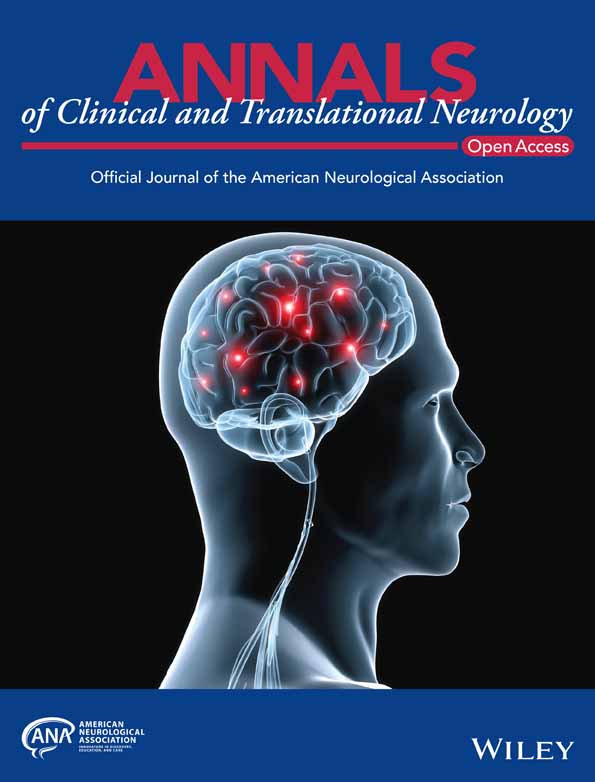LINC00323 variant is associated with increased risk of essential tremor
Abstract
Essential tremor (ET) is a common adult movement disorder, with accumulating evidence suggesting that genetic factors primarily account for ET risk. However, replication studies on the genetic variants have yielded inconsistent results. In our case–control study, we show that the LINC00323 variant, identified in a European GWAS study, is associated with an increased risk of ET in our Asian cohort. Our results corroborate the association of this risk variant with ET shared by diverse ethnicities. Functional studies of this variant have the potential to identify novel therapeutic targets for the general ET population.
Essential tremor (ET), characterized by postural and kinetic tremor, is one of the most common adult movement disorders, affecting more than 60 million people worldwide.1 Both genetic and environmental factors are implicated, with 18% of the heritability associated with common genetic variation.1, 2 A recent transcriptomic-wide association study found LINC00323 to have altered expression due to ET associated variant across different brain tissues.2 Consistently, a LINC00323 variant (rs9980363) was associated with ET in the European GWAS study.2 Here, we conduct a large case–control study to examine the association of the LINC00323 variant (rs9980363) with ET in an Asian cohort.
Method
Subjects were recruited from National Neuroscience Institute. The diagnosis of ET was made by movement disorders neurologists according to the Movement Disorder Society consensus diagnostic criteria.3 Controls had no clinical evidence of neurodegenerative conditions. Genotyping of rs9980363 was carried out by Taqman-based probe on 7500 real-time PCR (Life Technologies) and by Sanger sequencing analysis. Allele frequencies in ET and controls were compared using Chi-square test. Our study was approved by Singhealth Centralized Institutional Review Board. All subjects gave written informed consent.
Results
We included a total of 1222 subjects including 594 ET and 628 age and gender-matched controls without neurodegenerative diseases (Table 1). Carriers of rs9980363 were associated with a 1.4 times increased risk of ET compared to non-carriers (Odds ratio: 1.411; 95% CI 1.111–1.792, p = 0.005) (Table 1). Analysis of the subjects who reported a positive family history revealed a slightly higher risk of 1.609 (95% CI, 1.191–2.173, p = 0.002) compared to controls.
| ET (n = 594) | Controls (n = 628) | Odds ratio (OR) | p value | |
|---|---|---|---|---|
| Mean age ± SD | 52.6 ± 20.0 | 52.3 ± 9.9 | ||
| Median age (years) | 59.0 | 51.5 | ||
| Mean age at onset ± SD | 41.5 ± 21.4 | – | ||
| Median age (years) | 42.0 | |||
| Gender (male, %) | 340 (57.2%) | 363 (57.8%) | ||
| Wild type (TT) | 435 | 495 | ||
| Heterozygote (TC) | 143 | 129 | ||
| Homozygote (CC) | 16 | 4 | ||
| 1.411 (1.111–1.792) | 0.005 |
Discussion
Our study involving 1222 subjects with matched ET patients and healthy controls demonstrated a significant association between LINC00323 variant (rs9980363) and ET for the first time in an Asian population. Carriers of the variant have 1.4 times increased risk of ET compared to non-carriers. Those with a family history seem to have a marginally increased risk of 1.6 times. Overall, the 1.4 times risk is higher than the moderately increased risk (OR: 1.16) observed in Caucasians.2
LINC00323 belongs to a group of long intergenic noncoding RNA (lincRNA) genes and is classified as autonomously transcribed noncoding RNAs longer than 200 nucleotides. They do not overlap with annotated coding genes.4 LincRNA genes are implicated in RNA stabilization and transcription regulation as well as remodeling chromatin and genome architecture. They can regulate neighboring genes with specificity to certain tissues through sequence-independent regulatory functions and other mechanisms.4
LINC00323, highly expressed in the substantia nigra and spinal cord, is involved in the polarization of M1 macrophages and is closely related to the PI3K/AKT signaling pathway.5 Whole exome sequencing in ET identified genes implicated in biological pathways involving RNA binding and regulation of RNA processes and related AKT pathways.6 Due to the biological plausibility of lincRNA genes in ET pathophysiology, functional studies of LINC00323 RNA have the potential to identify novel therapeutic targets.
Our study has limitations. Although the effect size of rs9980363 in ET is significant, it does not prove a causal relationship. Experimental validation to assess the therapeutic potential of rs9980363 in ET will be useful. In addition, replication in independent cohorts is warranted to confirm the robustness of our findings.
Acknowledgements
We thank the National Medical Research Council (STaR and PD LCG 000207 to EK-T, CSA award to LL-C, and TA award to B-X).
Conflict of Interest Statement
The authors declare no competing interests.
Open Research
Data Availability Statement
The de-identified data will be available from the corresponding author upon reasonable request.




